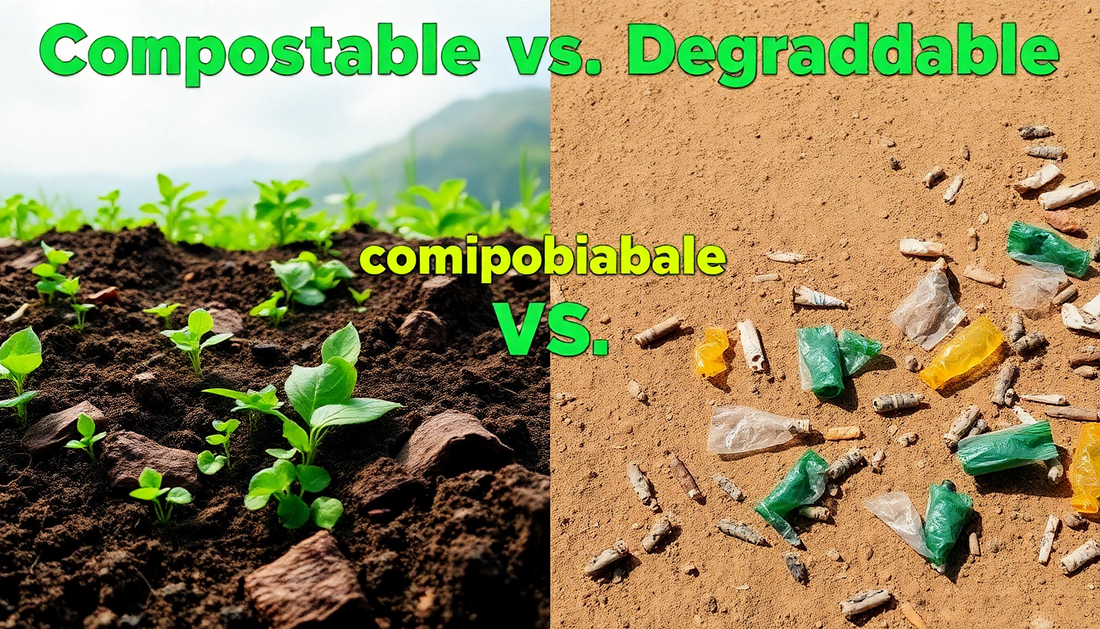As environmental concerns continue to grow, the search for sustainable alternatives to single-use plastics has become increasingly important. Two terms that are often used interchangeably, yet have distinct differences, are "compostable" and "degradable." Understanding these differences is crucial for making informed choices that can have a lasting impact on our planet.
Defining Compostable
Compostable materials are those that can be broken down by microorganisms, such as bacteria and fungi, into natural elements like carbon dioxide, water, and nutrient-rich soil. This process, known as composting, requires specific conditions, including the right balance of oxygen, moisture, and temperature. When these conditions are met, compostable materials can be transformed into a nutrient-rich soil amendment that can be used to enrich gardens and agricultural land.
Examples of compostable products include plant-based utensils, paper plates, and certain types of packaging made from materials like corn starch or bamboo. These items are designed to break down completely, leaving no harmful residues behind.
Defining Degradable
Degradable materials, on the other hand, are those that can break down over time, but not necessarily into natural, harmless elements. There are two main types of degradable materials: biodegradable and oxo-degradable.
Biodegradable materials are those that can be broken down by natural processes, such as the action of microorganisms, enzymes, or other environmental factors. This includes materials like paper, wood, and some types of plastics that are designed to break down more quickly than traditional plastics.
Oxo-degradable materials, on the other hand, are plastics that contain additives that accelerate the breakdown of the material when exposed to heat, light, or other environmental factors. However, this process does not necessarily result in the complete decomposition of the material, and it can leave behind microplastics or other harmful residues.
Key Differences Between Compostable and Degradable
The primary difference between compostable and degradable materials lies in the end products of their breakdown process. Compostable materials are designed to break down into natural, nutrient-rich soil, while degradable materials may leave behind microplastics or other potentially harmful residues.
Another key difference is the time frame for decomposition. Compostable materials typically break down within a matter of weeks or months, depending on the specific conditions, while degradable materials can take much longer to break down, sometimes taking years or even decades.
Environmental Benefits and Drawbacks
Compostable materials offer several environmental benefits, as they can be processed through industrial composting facilities or even home composting systems, ultimately returning valuable nutrients to the soil. This can help to reduce the amount of waste that ends up in landfills or oceans, and can also contribute to the growth of healthy, sustainable ecosystems.
Degradable materials, on the other hand, can have a more complex impact on the environment. While they may break down more quickly than traditional plastics, the residues they leave behind can still pose a threat to wildlife and the ecosystem. Additionally, the breakdown of some degradable materials can release harmful chemicals or microplastics into the environment.
Consumer Considerations
When it comes to making sustainable choices, it's important for consumers to understand the differences between compostable and degradable materials. This includes being aware of proper disposal methods, reading product labels carefully, and making informed decisions about the products they choose to use.
The Role of Reusable Products
While compostable and degradable materials can be a step in the right direction, the most sustainable solution is to choose reusable products whenever possible. This is where Builditfy's reusable cutlery comes into play. Lightweight, durable, and dishwasher-safe, our reusable cutlery is the perfect alternative to single-use plastics. By choosing reusable over compostable or degradable options, consumers can reduce their environmental impact and contribute to a greener tomorrow.
Conclusion
In the ongoing effort to reduce our environmental footprint, understanding the differences between compostable and degradable materials is crucial. Compostable materials offer a more sustainable solution, as they can be broken down into natural, nutrient-rich soil, while degradable materials can leave behind harmful residues. By making informed choices and opting for reusable products whenever possible, consumers can play a vital role in creating a more sustainable future.

